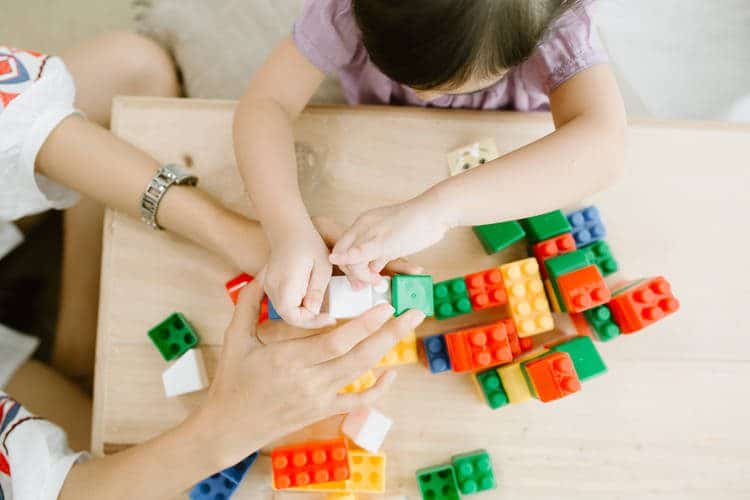As families spend more time at home due to sickness or cold weather, it’s common to feel stressed at the thought of being at home with energetic little ones. By planning early for this possibility and having some activities and experiences ready, you can feel less stressed and more prepared!
Start with a Toy Rotation
If you have a variety of toys, try a toy rotation. Pick a few toys to leave out for your child to play with and put the rest away out of sight. After a week or so, switch out the toys they’ve been using for the ones stored away, and boom, it feels like they have new toys!
We know their toys will only entertain for so long…and then boredom can set in. Boredom for infants and toddlers may not look the same as it does for us. Signs your little one is bored:
- Fussing or whining
- Struggling to focus or engage in play
- Becoming more aggressive
Parent-Child Play Ideas
As you look for activities to do with your child, consider offering different types of play to meet their needs and keep the fun going. Independent play (when children play by themselves with you nearby) is also an important type of play—and parents shouldn’t feel guilty about giving their babies and toddlers a chance to play on their own.
Here are some different ideas for play that you can try with your young child:
Outside time: Getting outside will probably be refreshing and a great change of scenery for all of you. No playground equipment is needed! Run, roll down hills, jump like kangaroos, or lie back and look at the clouds. Wash hands thoroughly after returning home from any outdoor play.
For infants:
- Bring their stroller outside for a walk or a story.
- Lay a blanket on the grass for tummy time.
- Enjoy bubbles, listen to music and sing together, talk about what you see outside.
- Park the stroller or hold your baby so they can watch an older sibling or other children play.
For toddlers:
- Play ‘I spy’ (keep it simple, “I spy something blue”, “I spy something that moves”).
- Collect rocks or leaves, then sort them by size, color, and shape.
- Kick, roll, or toss a ball back and forth.
- Dig in the dirt (don’t forget buckets, bowls, measuring cups, spoons, gardening tools, whatever you have!).
- Play with sidewalk chalk: draw pictures, trace one another’s outline, and more.
- Paint with water. Fill a cup with water and give your child a brush to “paint” the sidewalk, door, etc.
- Blow bubbles.
- Play “I’m going to catch you.”
- Pretend to be the different animals you might see in your neighborhood: Birds, squirrels, rabbits, deer, etc.
Most play that happens inside the house can also happen outside, so if the weather allows, bring some blocks outside, read together outdoors, color, or paint a cardboard box in the yard.
Physical Play: Little ones need to move and work their bodies…and voices. They will need opportunities to be loud, run, climb, and jump. This may happen outside or inside. Here are some ideas:
- Turn on some music and have a dance party.
- Put couch cushions on the floor and crawl, walk, or jump from one to the next (don’t touch the floor, it’s hot lava!).
- Use a bedsheet as a parachute (open it wide and raise it up above your heads, then bring it down to the floor). For infants, raise and lower a light blanket over them while playing peek-a-boo.
- Build a fort with sheets, blankets, couch cushions, pillows, chairs, and more. You can even “camp-out” indoors!
- Create an obstacle course using furniture, pillows, and toys.
Quiet Play: Children (and you) will also need some quiet time each day. This is great for relaxing, recharging, and maybe even allowing you to get some work done.
- Read together or independently (toddlers can flip through books and talk about what they see in the illustrations)
- Coloring
- Puzzles
- Block building
- Sorting objects
- Pretend play with stuffed animals, dolls, trains, cars, or kitchen items for “playing house”
- Stickers on paper – you can draw large shapes, letters, or numbers on paper and your child can line the shape with stickers
- Tape on paper – you can cut short pieces of masking tape and your child can stick it to a piece of paper (sounds boring, but little ones love it).
Remember that one of the most favorite types of play for children is helping you with “real” work. Think about whether your toddler can help with meal preparation, setting the table, sorting or putting away laundry, cleaning up (for example, putting shoes in the closet) or putting new toilet paper rolls in a basket in the bathroom. These tasks may take a bit longer with our toddlers, but it’s fun for them and also teaches the value of cooperation.
Thinking About Your Daily Routine
Try to keep daily routines as stable as possible during this break. As much as possible, try to stick to daily routines, with wake-up times, meals, naps, and bedtimes as usual. Children thrive on predictability, and it’s good for their caregivers, too. (It’s much easier to deal with a long day with little ones if it’s divided into smaller, more manageable pieces.)
For a deeper dive into activities to do at home with your infants and toddlers to promote their development, and keep them (and you) from feeling trapped in the house, check out A Year of Play and Play With Me!.




